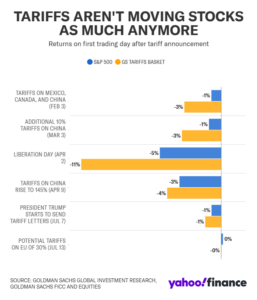Stocks aren’t moving on tariff headlines like they used to.
This trend has been evident over the past several weeks as equities have continued to rise to record highs despite ongoing threats from President Trump regarding escalating tariffs on a variety of countries.
In a recent note to clients, Goldman Sachs chief US equity strategist David Kostin analyzed the performance of the S&P 500 (^GSPC) and a basket of stocks with “broad tariff exposure.” Through April, both stocks had been reacting aggressively to tariff announcements from Trump.
But as the below chart shows, the reactions have become increasingly smaller during Trump’s latest flurry of letters detailing reciprocal tariffs throughout July.
“Our client conversations indicate that many investors believe tariff rates will eventually settle lower than what the recent announcements have indicated,” Kostin wrote.

Kostin noted that, up to this point, economic data on consumer spending, inflation, and the labor market have shown a “smaller impact” from tariffs than many investors have feared. This resiliency, which also emerged in the early reporting period for second quarter financial updates from S&P 500 companies, has been backing the market’s chug higher to fresh records.
“Equity investors appear to be looking through potential near-term economic and earnings weakness and focusing instead on the prospect for robust growth in 2026,” Kostin wrote.
Kostin expects the S&P 500 to gain another 5% in the next six months and 10% in the next 12 months. That call is predicated in part on “investors’ continued willingness to focus on the solid longer-term trajectory of earnings growth,” per Kostin.

The S&P 500 moved 1% or less on two of President Trump’s busiest days of tariff announcements in July, reversing a trend from earlier this year when tariff announcements were driving the market action. (TIMOTHY A. CLARY/AFP via Getty Images) TIMOTHY A. CLARY via Getty Images
Morgan Stanley chief investment officer Mike Wilson also expressed optimism about the outlook for stocks in the intermediate term, writing in a note to clients he’s “leaning toward” his bull case for the S&P 500, which would bring the benchmark index to 7,200 in the next year. That stance relies on corporate earnings resilience and the lack of impact seen from tariffs thus far.
“An under appreciated aspect of the earnings story into 2026 is that positive operating leverage is returning due in part to lower wage costs, and it may be further enhanced by AI adoption,” Wilson wrote. “We’re also not hearing a significant level of concern from corporates in terms of tariff-related costs impacting margins thus far, though we could hear more about this risk in 3Q.”
Written by Josh Shafer of Yahoo! Finance.
Shared by Golden State Mint on GoldenStateMint.com














